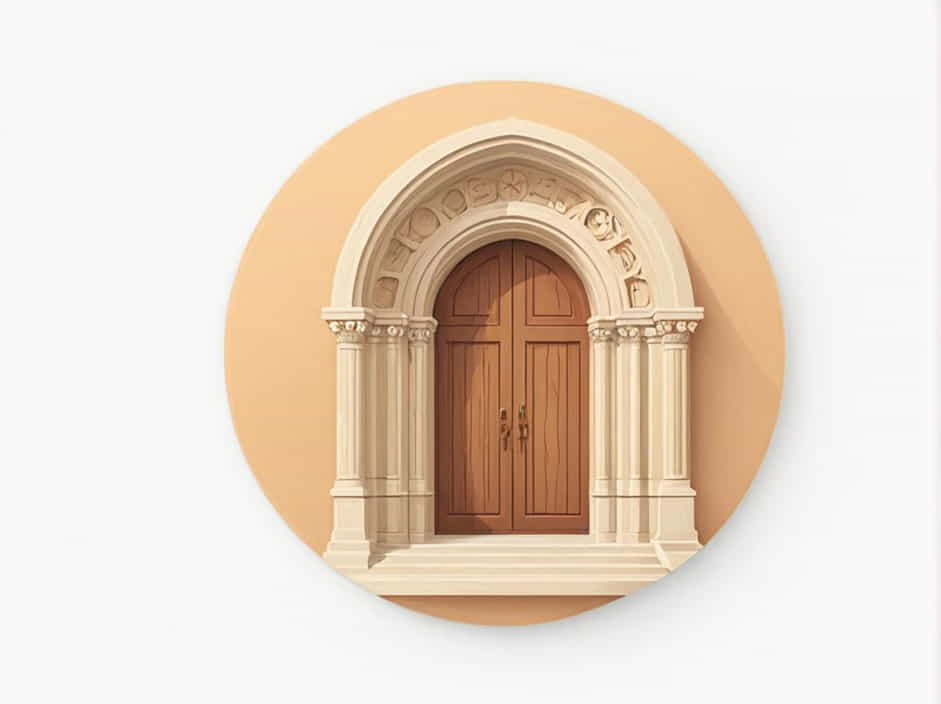The entrance portal of a Romanesque cathedral was more than just an entryway—it was a grand, symbolic gateway that conveyed religious themes and spiritual significance. Adorned with intricate carvings and biblical imagery, the portal served as a visual representation of Christian beliefs, offering both guidance and awe to those who entered.
This topic explores the symbolism behind Romanesque cathedral portals, their architectural elements, and their role in medieval society.
The Importance of the Entrance Portal in Romanesque Architecture
Romanesque cathedrals were built between the 10th and 12th centuries, characterized by their thick walls, rounded arches, and massive structures. The entrance portal was a focal point of these cathedrals, often richly decorated to communicate Christian teachings to the largely illiterate medieval population.
1. A Gateway to the Divine
The entrance portal symbolized the transition from the earthly world to the sacred space of the cathedral. As believers approached, they were reminded that they were stepping into a place of worship, leaving behind their worldly concerns.
✔ Symbolism: The portal represented the passage from sin and mortality to salvation and eternal life.
2. Biblical Stories in Stone
Romanesque portals were adorned with elaborate carvings depicting scenes from the Bible, often arranged in a hierarchical composition. The most common themes included:
- The Last Judgment – A powerful reminder of divine justice, often carved on the tympanum (the semi-circular area above the doorway).
- Christ in Majesty – Depicting Jesus as the supreme ruler, surrounded by angels and saints.
- Scenes from the Old and New Testament – Telling stories from scripture to educate and inspire worshippers.
✔ Symbolism: These carvings acted as a visual sermon, teaching moral and religious lessons to those entering the cathedral.
Key Architectural Elements of the Romanesque Portal
The entrance portal of a Romanesque cathedral was not just a doorway but a masterpiece of architectural and artistic expression. The main components included:
1. Tympanum – The Spiritual Message
The tympanum was the most important decorative feature of the portal, often depicting the Last Judgment or Christ in Glory.
✔ Symbolism: This area reminded visitors of their faith, mortality, and ultimate fate after death.
2. Archivolts – The Heavenly Arch
The archivolts were the curved moldings surrounding the tympanum, often adorned with angels, prophets, and biblical figures.
✔ Symbolism: They represented the heavenly hierarchy and the divine order of the universe.
3. Lintel – The Supporting Foundation
The lintel, located just below the tympanum, often contained additional carvings that expanded on the scene above.
✔ Symbolism: It acted as the foundation of faith, reinforcing the message of the tympanum.
4. Jambs and Trumeau – The Guardians of the Portal
The jambs (the vertical sides of the doorway) and trumeau (the central supporting column) were often carved with statues of saints, apostles, or Old Testament figures.
✔ Symbolism: These figures served as spiritual guardians, guiding and protecting those who entered the cathedral.
The Role of the Portal in Medieval Society
The Romanesque portal was not just an artistic feature but also played a significant role in medieval religious life.
1. A Teaching Tool for the Illiterate
During the Middle Ages, most people were illiterate, meaning they could not read the Bible for themselves. The detailed carvings on the portal served as a visual Bible, helping the faithful understand Christian teachings.
✔ Symbolism: The portal acted as a storybook in stone, ensuring that the message of the Church reached everyone.
2. A Place of Judgment and Reflection
Before entering the cathedral, believers would often pause before the portal to reflect on their actions and faith. The scenes of the Last Judgment served as a reminder to live a righteous life.
✔ Symbolism: The portal represented the choice between salvation and damnation, urging people to follow the path of righteousness.
3. A Grand Entrance for Pilgrims
Many Romanesque cathedrals were located along pilgrimage routes, attracting thousands of visitors seeking spiritual renewal. The entrance portal welcomed them, offering a glimpse of the divine before they even stepped inside.
✔ Symbolism: The portal symbolized the pilgrim’s journey to heaven, reinforcing the idea of the cathedral as a sacred destination.
Famous Romanesque Cathedral Portals
Several Romanesque cathedrals are renowned for their intricately designed portals, each reflecting the spiritual and artistic ideals of the time.
1. Autun Cathedral (France)
- Features a stunning Last Judgment scene on its tympanum, sculpted by Gislebertus.
- Christ is depicted as a majestic ruler, separating the saved from the damned.
2. Moissac Abbey (France)
- Showcases a detailed Christ in Majesty tympanum.
- The archivolts feature intricate depictions of angels and elders.
3. Santiago de Compostela (Spain)
- A major pilgrimage site with a grand Romanesque entrance known as the Portico of Glory.
- Features a depiction of Saint James welcoming pilgrims.
The entrance portal of a Romanesque cathedral was a powerful symbol of faith, judgment, and salvation. Through its grand architecture and intricate carvings, it communicated religious messages to medieval worshippers, serving as both an artistic masterpiece and a spiritual gateway.
Whether depicting the Last Judgment, Christ in Glory, or biblical stories, these portals remain an enduring testament to the deep religious devotion and artistic brilliance of the Romanesque period.
Powered by # ChatGPT Conversation
User: angga angga ([email protected])
Created: 7/3/2025, 16.35.14
Updated: 7/3/2025, 17.21.53
Exported: 13/3/2025, 15.52.40
